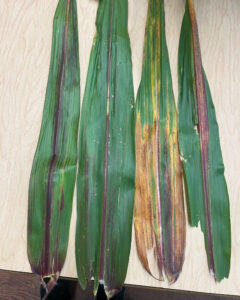Comprehending the Changing Colors of Corn Leaves
go.ncsu.edu/readext?1015651
en Español / em Português
El inglés es el idioma de control de esta página. En la medida en que haya algún conflicto entre la traducción al inglés y la traducción, el inglés prevalece.
Al hacer clic en el enlace de traducción se activa un servicio de traducción gratuito para convertir la página al español. Al igual que con cualquier traducción por Internet, la conversión no es sensible al contexto y puede que no traduzca el texto en su significado original. NC State Extension no garantiza la exactitud del texto traducido. Por favor, tenga en cuenta que algunas aplicaciones y/o servicios pueden no funcionar como se espera cuando se traducen.
Português
Inglês é o idioma de controle desta página. Na medida que haja algum conflito entre o texto original em Inglês e a tradução, o Inglês prevalece.
Ao clicar no link de tradução, um serviço gratuito de tradução será ativado para converter a página para o Português. Como em qualquer tradução pela internet, a conversão não é sensivel ao contexto e pode não ocorrer a tradução para o significado orginal. O serviço de Extensão da Carolina do Norte (NC State Extension) não garante a exatidão do texto traduzido. Por favor, observe que algumas funções ou serviços podem não funcionar como esperado após a tradução.
English
English is the controlling language of this page. To the extent there is any conflict between the English text and the translation, English controls.
Clicking on the translation link activates a free translation service to convert the page to Spanish. As with any Internet translation, the conversion is not context-sensitive and may not translate the text to its original meaning. NC State Extension does not guarantee the accuracy of the translated text. Please note that some applications and/or services may not function as expected when translated.
Collapse ▲While we are seeing more rain, the drought has turned green corn plants into various shades of yellow and brown. However, there are a few other colors you may see in a field. Read below to know what the different colors may indicate:
Reddish-Purple
Early season reddish-purple streaking may be a sign of phosphorus deficiency. However in late season corn, this purple hue can be a sign of anthocyanin production. Anthocyanins are naturally occurring pigments that form to absorb excess light and help corn tolerate excessively sunny conditions, similar to how melanin protects our skin. These pigments make plants shades of reddish-purple. Additionally, anthocyanins can be caused by a buildup of sugar in leaves, which may indicate that the sugar is not being fully utilized or the flow of sugar is disrupted. Drought conditions can lead to small or missing corn ears, resulting in unused sugar. Stress and stalk damage may disrupt sugar flow.
Orange
If orange specks are observed on corn, it may be corn rust. Immediate treatment may not be needed, but it is essential to monitor the corn for development and spread to determine the appropriate management approach. See corn rust and southern rust for more information.
‘Dusty’ black/gray
Common smut has been prevalent this season, as it is favored by hot, dry conditions and worsens when kernels are injured. Infected corn kernels are full of black spores that may spread, contributing to a dusty black appearance on surrounding leaves. It is recommended to remove the infected kernels (galls) or ears before they rupture to minimize spread. The spores can survive in the soil for 5-7 years, though cultural practices that manage ear rots are also useful at managing common smut.
The late season rainfall we are experiencing also provides conducive conditions for saprophytic fungi, such as Alternaria spp. that grow on dead leaves and husks. These fungi do not usually cause ear damage and do not need to be managed.
With tar spot of corn spreading throughout the Midwest and Southeast regions, black spots are a concern for every corn grower. Tar spot has not been reported in North Carolina, though it is important to familiarize yourself with the disease. If tar spot is suspected, please contact your extension agent. Extension agents should report suspected cases to extension pathologist, Daisy Ahumada: daisy_ahumada@ncsu.edu.
For more information on other causes of changing corn leaf colors, see the following:
Early season corn nutrient deficiencies
Soil Fertility – Deficiencies Symptoms
Managing nutrient deficiencies
Corn – Corn Fertility Management
Corn Foliar Diseases




